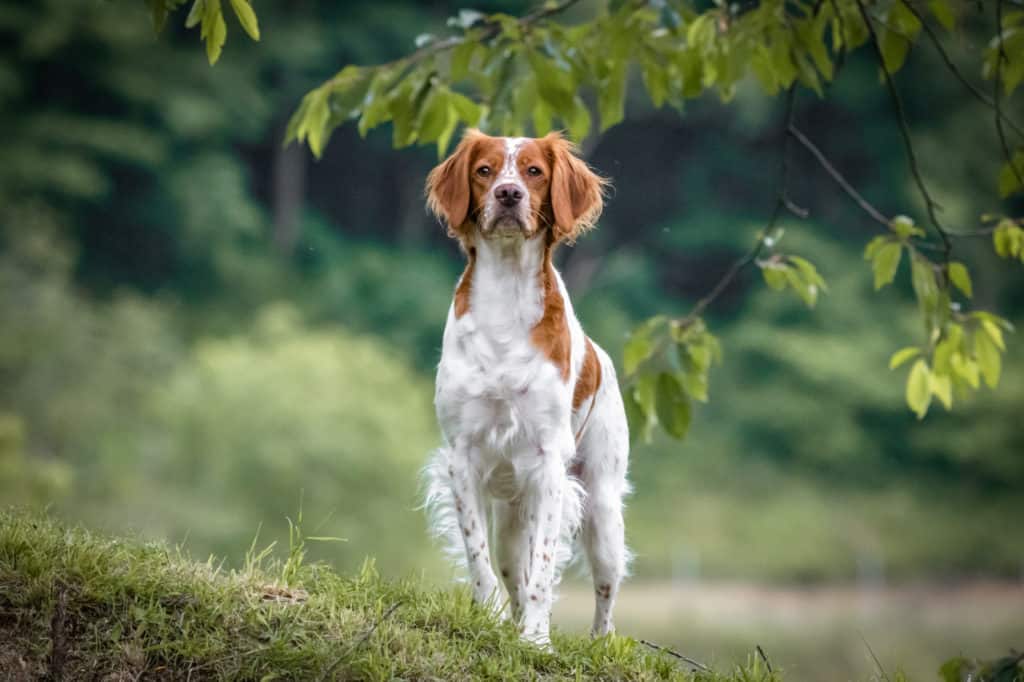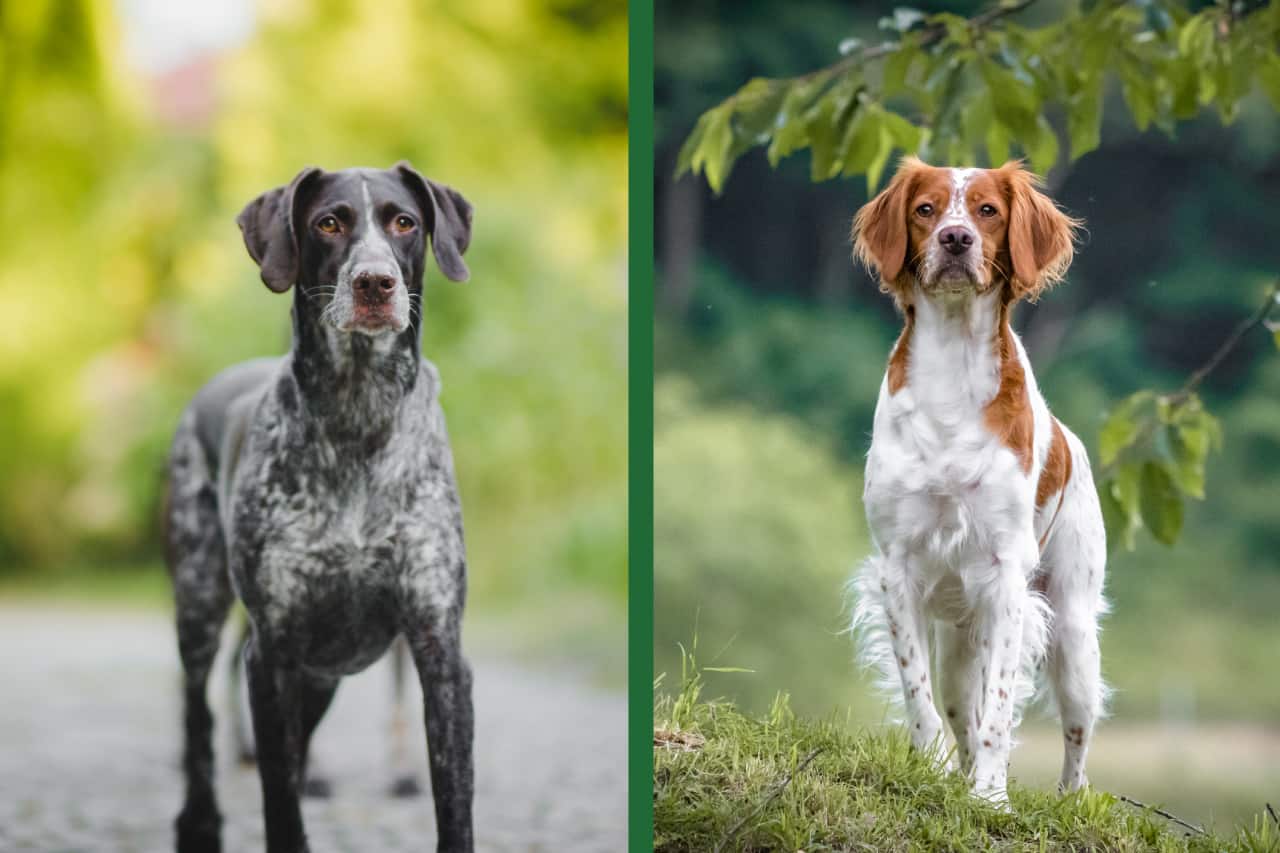German Pointers and Brittanys are amazing sporting dogs, ideal for active owners and especially for practicing hunters. As bird dogs, German Pointers and Brittanys are undoubtedly high maintenance, but their differences beyond this introduce other home and ownership requirements.
German Pointers shed more than Brittanys. German Pointers are more intense and stubborn than a Brittany. Brittanys are better with strangers, children, other dogs, and cats than German Pointers. German Pointers and Brittanys are well-matched in energy, exercise requirements, and living requirements.
There are three different German Pointer types: German Longhaired Pointer, German Shorthaired Pointer, and German Wirehaired Pointer. They share some similarities but are different enough to be classified as separate breeds. This article will compare each of these German Pointers to the Brittany.
Please note that the below details are the breed standards and most commonly seen behaviors and characteristics. However, there are individual differences. Temperament particularly is influenced by other factors, such as personality, age, quality of breeding, socialization, training, history, and living environment.
German LONGHAIRED Pointer Vs. Brittany
Classification, Lifespan, And Appearance
| GERMAN LONGHAIRED POINTER | BRITTANY | |
| AKC Classification | Foundation Stock Service | Sporting Group |
| Alternative Classification | Bird Dog – Pointer | Bird dog – Versatile |
| Lifespan | 12-14 years | 12-14 Years |
| Height | 22-28 inches | 17.5-20.5 inches |
| Weight | 55-80 lbs | 30-40 lbs |
| Coat Length | Medium to long | Medium |
| Coat Characteristics | Sleek with undercoat | Not wiry or silky |
| Feathering | Moderate; on ears, back of all legs, and tail | Moderate; on legs |
| Hypoallergenic Coat | No | No |
| Ears | Hang down; medium to long; feathered | Hang down; short to medium; hair but not feathered |
Summary:
German Longhaired Pointers are pointing bird dogs, bred to locate game and use their bodies to indicate this position to their human hunting companions without disturbing the game. They do retrieve as well, but more as a convenience to the hunter. The Brittany used to be classified as a Spaniel (flushing bird dog), but their versatility and ability to point and retrieve as well led the AKC to drop the ‘Spaniel’.
German Longhaired Pointers are taller and approximately double the weight of the Brittany. Brittanys do not have an undercoat like the German Longhaired Pointers and are less feathered.
Grooming Requirements
| GERMAN LONGHAIRED POINTER | BRITTANY | |
| Maintenance Intensity | Moderate | Low to moderate |
| Brushing | Weekly | 2-3 times a week |
| Bathing | Occasional | As needed |
| Shedding | Infrequent | Seasonal |
| Ears | Checked daily; cleaned weekly; brushed 2-3 time a week | Checked daily; cleaned weekly; brushed 2-3 time a week |
Summary:
German Longhaired Pointers are infrequent shedders, whereas Brittanys go through seasonal shedding, during which time their brushing requirements will be at their highest.
Temperament
| GERMAN LONGHAIRED POINTER | BRITTANY | |
| General Temperament (AKC) | Versatile; calm; family-oriented | Bright; fun-loving; upbeat |
| Affectionate (to family) | Yes; often prefers one person | Yes |
| Independence | Low | Low to moderate |
| Intensity | Moderate | Moderate |
| Sensitivity | Moderate | High |
| Stubborn | Unlikely | Unlikely |
| Aggression Level | Low | Low |
| Timid | Unlikely | Unlikely |
| Energy Level | High | High |
| Attention Requirements | High | High |
| One-Person Dog | Likely | Possible |
| General Friendliness | High | High |
| Child Friendliness | High | High |
| Stranger Friendliness | Friendly | Friendly |
| Dog Friendliness | Moderate to high | High |
| Cat Friendliness | Low | Moderate (when raised with them) |
| Protectiveness | Low to moderate | Low to moderate |
| Prey Drive | High | High |
| Barking Potential | Moderate | Moderate to high |
Summary:
Brittanys are less likely to be one-person dogs than German Longhaired Pointers, although both breeds are still appropriate for multi-person homes. In fact, multi-person homes may be more ideal as there are more people to help meet these breeds’ high exercise requirements. German Longhaired Pointers are less sensitive than Brittanys and less prone to nuisance barking.
Brittanys are better with other dogs and cats than German Longhaired Pointers, but they do need to be raised with cats and their prey drive is still high.
Exercise And Training Requirements
| GERMAN LONGHAIRED POINTER | BRITTANY | |
| Socialization | Required | Required |
| Intelligence Level | High | High |
| Endurance | High | High |
| Eager to Please | High | High |
| Exercise Needs | High | High |
| Exercise Frequency | 2-3 times a day | 2-3 times a day |
| Exercise Duration | 30-60 minutes per session | 30-60 minutes per session |
| Exercise Intensity | Moderate to high | High |
| Owner Requirements | Active | Active |
| Exercise Companion | Good | Excellent |
| Training Methods | Positive preferred | Positive preferred |
| Mandatory Training | Obedience | Obedience |
| Canine Sport Training | Eligible | Eligible |
| Affinity for Water | High | High |
Summary:
German Longhaired Pointers and Brittanys are very evenly matched when it comes to exercise and training requirements.
Adaptability And Living Environment
| GERMAN LONGHAIRED POINTER | BRITTANY | |
| Good for First-Time Owners | Possibly | No |
| Good for Single-Person Homes | Yes | Yes (if person can meet their exercise requirements) |
| Good for Multi-Person Homes | Yes | Yes |
| Alone Time | Intolerant | Tolerate short amounts of alone time |
| Indoor Living | Should be allowed indoors with family; not suitable for apartment living | Should be allowed indoors with family; not suitable for apartment living |
| Outdoor Requirements | Should have access to a secure yard; should be taken outside each day | Should have access to a secure yard; should be taken outside each day |
| Toleration of Cold Weather | Moderate | Moderate to high |
| Toleration of Hot Weather | Low to moderate | Moderate |
Summary:
German Longhaired Pointers would be more appropriate for a certain kind of novice owner than a Brittany. German Longhaired Pointers are less tolerant of alone time than Brittanys. However, you should not leave a Brittany alone for long periods as they can become distressed and destructive.

German SHORTHAIRED Pointer Vs. Brittany
Classification, Lifespan, And Appearance
| GERMAN SHORTHAIRED POINTER | BRITTANY | |
| AKC Classification | Sporting Group | Sporting Group |
| Alternative Classification | Bird Dog – Pointer | Bird dog – Versatile |
| Lifespan | 10-12 years | 12-14 Years |
| Height | 21-25 inches | 17.5-20.5 inches |
| Weight | 45-70 lbs | 30-40 lbs |
| Coat Length | Very short | Medium |
| Coat Characteristics | Thick and coarse on body; thinner and softer on head and ears | Not wiry or silky |
| Feathering | None | Moderate; on legs |
| Hypoallergenic Coat | No | No |
| Ears | Hang down; medium to long; un-feathered | Hang down; short to medium; hair but not feathered |
Summary:
German Shorthaired Pointers are pointing bird dogs. Brittanys are versatile and able to point, flush, and retrieve.
German Shorthaired Pointers are larger than the Brittany, and they have thicker, coarser, and shorter coats than Brittanys. Brittanys have more feathering than German Shorthaired Pointers.
Grooming Requirements
| GERMAN SHORTHAIRED POINTER | BRITTANY | |
| Maintenance Intensity | Moderate | Low to moderate |
| Brushing | Occasional | 2-3 times a week |
| Bathing | Occasional | As needed |
| Shedding | Regular | Seasonal |
| Ears | Checked and cleaned weekly | Checked daily; cleaned weekly; brushed 2-3 time a week |
Summary:
German Shorthaired Pointers require less regular brushing but are more likely to shed than Brittanys. A Brittany’s ears require more attention than the German Shorthaired Pointer’s.
Temperament
| GERMAN SHORTHAIRED POINTER | BRITTANY | |
| General Temperament (AKC) | Friendly; smart; willing to please | Bright; fun-loving; upbeat |
| Affectionate (to family) | Yes; often prefers one person | Yes |
| Independence | Moderate | Low to moderate |
| Intensity | Moderate to high | Moderate |
| Sensitivity | Moderate to high | High |
| Stubborn | Possible | Unlikely |
| Aggression Level | Low | Low |
| Timid | No | Unlikely |
| Energy Level | High | High |
| Attention Requirements | High | High |
| One-Person Dog | Likely | Possible |
| General Friendliness | Moderate | High |
| Child Friendliness | Moderate to high; better with older children | High |
| Stranger Friendliness | Reserved to friendly | Friendly |
| Dog Friendliness | Low | High |
| Cat Friendliness | Low | Moderate (when raised with them) |
| Protectiveness | Moderate to high | Low to moderate |
| Prey Drive | High | High |
| Barking Potential | Moderate | Moderate to high |
Summary:
Brittanys are less likely to be one-person dogs than German Shorthaired Pointers, although both breeds are still appropriate for multi-person homes. In fact, multi-person homes may be more ideal as there are more people to help meet these breeds’ high exercise requirements.
German Shorthaired Pointers are more intense but less sensitive than Brittanys.
German Shorthaired Pointers have a higher likelihood of being stubborn than Brittanys, but they are less prone to nuisance barking.
Brittanys are generally more friendly than German Shorthaired Pointers and are better with strangers, children, other dogs, and cats (if raised with them).
Exercise And Training Requirements
| GERMAN SHORTHAIRED POINTER | BRITTANY | |
| Socialization | Required | Required |
| Intelligence Level | High | High |
| Endurance | High | High |
| Eager to Please | High | High |
| Exercise Needs | High | High |
| Exercise Frequency | 2-3 times a day | 2-3 times a day |
| Exercise Duration | 30-60 minutes per session | 30-60 minutes per session |
| Exercise Intensity | Moderate to high | High |
| Owner Requirements | Active | Active |
| Exercise Companion | Excellent | Excellent |
| Training Methods | Positive yields best results; shorter duration is better | Positive preferred |
| Mandatory Training | Obedience | Obedience |
| Canine Sport Training | Encouraged | Eligible |
| Affinity for Water | Moderate to high | High |
Summary:
German Shorthaired Pointers and Brittanys are very evenly matched when it comes to exercise and training requirements, although the German Shorthaired Pointer requires more task-based exercise. The Brittany does well with tasks but can also be satisfied with park and yard play.
Adaptability And Living Environment
| GERMAN SHORTHAIRED POINTER | BRITTANY | |
| Good for First-Time Owners | No | No |
| Good for Single-Person Homes | Yes (if person can meet their exercise requirements) | Yes (if person can meet their exercise requirements) |
| Good for Multi-Person Homes | Yes | Yes |
| Alone Time | Intolerant | Tolerate short amounts of alone time |
| Indoor Living | Should be allowed indoors with family; not suitable for apartment living | Should be allowed indoors with family; not suitable for apartment living |
| Outdoor Requirements | Should have access to a secure yard; should be taken outside each day | Should have access to a secure yard; should be taken outside each day |
| Toleration of Cold Weather | Low | Moderate to high |
| Toleration of Hot Weather | Moderate to high | Moderate |
Summary:
With their short coats, German Shorthaired Pointers are less tolerant of the cold but more tolerant of heat than the Brittany. German Shorthaired Pointers are less tolerant of alone time than Brittanys. However, you should not leave a Brittany alone for long periods as they can become distressed and destructive.

German WIREHAIRED Pointer Vs. Brittany
Classification, Lifespan, And Appearance
| GERMAN WIREHAIRED POINTER | BRITTANY | |
| AKC Classification | Sporting Group | Sporting Group |
| Alternative Classification | Bird Dog – Pointer | Bird dog – Versatile |
| Lifespan | 14-16 years | 12-14 Years |
| Height | 22-26 inches | 17.5-20.5 inches |
| Weight | 50-70 lbs | 30-40 lbs |
| Coat Length | Short (longer on belly) | Medium |
| Coat Characteristics | Straight, harsh, and wiry; undercoat is dense in winter and thin in summer | Not wiry or silky |
| Feathering | Little to none | Moderate; on legs |
| Hypoallergenic Coat | No | No |
| Ears | Hang down; short to medium; un-feathered | Hang down; short to medium; hair but not feathered |
Summary:
German Wirehaired Pointers are pointing bird dogs. Brittanys are versatile and able to point, flush, and retrieve.
German Wirehaired Pointers are bigger than Brittanys and have wirier coats with an undercoat. Brittanys have no undercoat but have more feathering than German Wirehaired Pointers.
Grooming Requirements
| GERMAN WIREHAIRED POINTER | BRITTANY | |
| Maintenance Intensity | Low | Low to moderate |
| Brushing | Weekly | 2-3 times a week |
| Bathing | Occasional | As needed |
| Shedding | Regular | Seasonal |
| Ears | Checked and cleaned weekly | Checked daily; cleaned weekly; brushed 2-3 time a week |
Summary:
German Wirehaired Pointers require less regular brushing but are more likely to shed than Brittanys. A Brittany’s ears require more attention than the German Wirehaired Pointer’s.
Temperament
| GERMAN WIREHAIRED POINTER | BRITTANY | |
| General Temperament (AKC) | Affectionate; eager; enthusiastic | Bright; fun-loving; upbeat |
| Affectionate (to family) | Yes; often prefers one person | Yes |
| Independence | Moderate | Low to moderate |
| Intensity | Moderate to high | Moderate |
| Sensitivity | Moderate to high | High |
| Stubborn | Possible | Unlikely |
| Aggression Level | Moderate (dog aggression) | Low |
| Timid | No | Unlikely |
| Energy Level | High | High |
| Attention Requirements | High | High |
| One-Person Dog | Likely | Possible |
| General Friendliness | High | High |
| Child Friendliness | High (can be too boisterous) | High |
| Stranger Friendliness | Reserved | Moderate to high |
| Dog Friendliness | Low | High |
| Cat Friendliness | Low | Moderate (when raised with them) |
| Protectiveness | High | Low to moderate |
| Prey Drive | High | High |
| Barking Potential | Moderate | Moderate to high |
Summary:
German Wirehaired Pointers are more intense but less independent and sensitive than Brittanys.
German Wirehaired Pointers are more likely to be stubborn and aggressive (mostly limited to dog-dog aggression) than Brittanys, but they are less prone to nuisance barking.
Brittanys are less likely to be one-person dogs than German Wirehaired Pointers, although both breeds are still appropriate for multi-person homes. In fact, multi-person homes may be more ideal as there are more people to help meet these breeds’ high exercise requirements.
Brittanys are friendlier overall and more appropriate for children and multi-pet homes than German Wirehaired Pointers, but you cannot say that German Wirehaired Pointers are unfriendly.
Exercise And Training Requirements
| GERMAN WIREHAIRED POINTER | BRITTANY | |
| Socialization | Required | Required |
| Intelligence Level | High | High |
| Endurance | High | High |
| Eager to Please | High | High |
| Exercise Needs | High | High |
| Exercise Frequency | 2-3 times a day | 2-3 times a day |
| Exercise Duration | 30-60 minutes per session | 30-60 minutes per session |
| Exercise Intensity | High | High |
| Owner Requirements | Active | Active |
| Exercise Companion | Excellent | Excellent |
| Training Methods | Positive preferred | Positive preferred |
| Mandatory Training | Obedience | Obedience |
| Canine Sport Training | Encouraged | Eligible |
| Affinity for Water | High | High |
Summary:
German Wirehaired Pointers and Brittanys are very evenly matched when it comes to exercise and training requirements, although the German Wirehaired Pointer requires more task-based exercise. The Brittany does well with tasks but can also be satisfied with park and yard play.
Adaptability And Living Environment
| GERMAN WIREHAIRED POINTER | BRITTANY | |
| Good for First-Time Owners | No | No |
| Good for Single-Person Homes | Yes | Yes (if person can meet their exercise requirements) |
| Good for Multi-Person Homes | Yes | Yes |
| Alone Time | Intolerant of extended periods of isolation | Tolerate short amounts of alone time |
| Indoor Living | Should be allowed indoors with family; not suitable for apartment living | Should be allowed indoors with family; not suitable for apartment living |
| Outdoor Requirements | Should have access to a secure yard; should be taken outside each day | Should have access to a secure yard; should be taken outside each day |
| Toleration of Cold Weather | Moderate to high | Moderate to high |
| Toleration of Hot Weather | Moderate to high | Moderate |
Summary:
German Wirehaired Pointers and Brittanys are well-matched in terms of required living conditions and adaptability.
Conclusion
There are three different breeds of German Pointer. Brittanys are more friendly with strangers, children, other dogs, and cats than any of the German Pointer breeds.
German Pointers are more stubborn and intense than Brittanys. German Pointers can also be more aggressive than the Brittany, although they are not aggressive dogs overall.
German Pointers and Brittanys are well-matched in terms of their energy levels, how much exercise they require, their required living environment, and their adaptability.
All of these breeds are not appropriate for novice owners. They require dedicated and extremely active owners who can and will invest lots of time and effort into training and exercising their dogs.
References
https://dogtime.com/dog-breeds/german-longhaired-pointer#/slide/1
https://www.akc.org/dog-breeds/german-longhaired-pointer/
https://www.akc.org/dog-breeds/german-shorthaired-pointer/
https://www.orvis.com/german-shorthaired-pointer
https://dogtime.com/dog-breeds/german-shorthaired-pointer#/slide/1
https://dogtime.com/dog-breeds/german-wirehaired-pointer#/slide/1
https://www.akc.org/dog-breeds/german-wirehaired-pointer/
https://www.orvis.com/german-wirehaired-pointer
https://dogtime.com/dog-breeds/brittany#/slide/1

